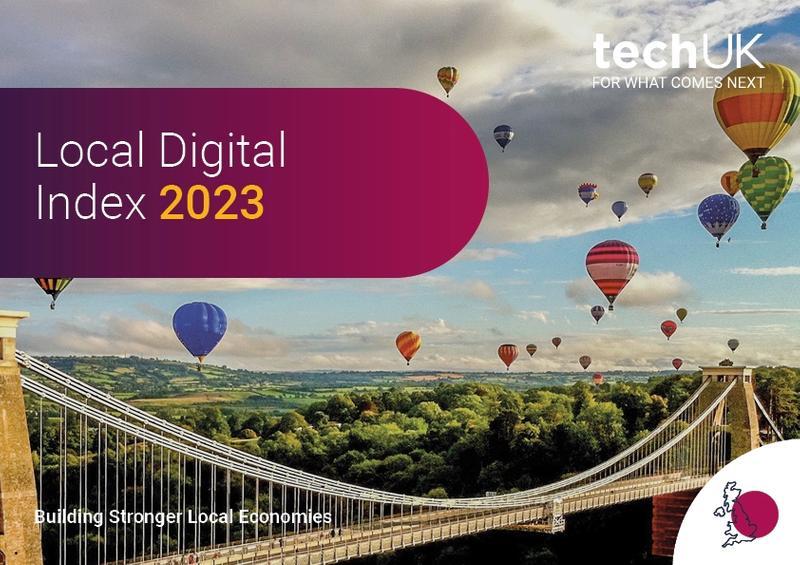Local Digital Index 2023
The Local Digital Index, which has expanded significantly since its inception in response to the evolving tech landscape, offers valuable insights into key aspects of the UK’s tech ecosystem. This is a guide that describes the impact and value technology can bring to a region, showcasing its strengths and providing direction for development. It can be used by policy makers to address the challenges faced by each nation and region in the UK more confidently using data that shows where investment should be directed. The Index helps build a strong tech ecosystem between sectors, policy makers, companies and government by providing data that encourages collaboration between regions.

Three years on, the Local Digital Index still presents a varied picture of the UK's tech sector across the nations and regions amidst challenging economic conditions, both domestically and internationally. While the digital ecosystems across the UK have overall improved since 2020 thanks to government and business intervention, a concern emerges that technological innovation may be outpacing the speed at which the UK is embracing these transformative changes.
techUK’s Local Digital Index shows there are great examples of innovation, funding, skills, connectivity and more across the UK. To track and monitor this in the future there must be a move to improve the data captured, shared and analysed. Making more of this data publicly available helps to see the true picture of our digital sector and economy.
Jump to section here:
Local Digital Index highlights | Local Digital Index recommendations | How Does Your Area Compare? | Download the report
Local Digital Index ranking table
Skills
Digital Adoption
Digital Infrastructure
Research & Development
Finance & Investment
Trade
Digital Ecosystems
How to use
The map on the left shows how each area ranks in this year's Local Digital Index, with higher ranking areas appearing darker on the map. You can zoom in and out using your scroll wheel. If you get lost, press 'Reset Zoom' to go back to the original view. Hovering over an area will display more detail about in this panel.
Pressing on one of the buttons above will filter the data to show you how each area ranks in each of the constituent metrics that make up the Local Digital Capital Index: Skills; Digital Adoption; Infrastructure; Finance and Investment; Research and Development; and Trade. More detail on the methodology can be found below.
The table below shows the full data from the 2023 Local Digital Index for each of the NUTS2 areas. You can sort on each of the metrics using the arrows in the table header.
Highlights from Local Digital Index 2023
-
Gross Value Added (GVA) – In this year’s iteration of the Local Digital Index, we added the economic productivity metric, Gross Value Added (GVA) for the digital sector in each region and what this means per person. This brought a new significance to the Index and shows that digital capital is key to unlocking local economic growth. Our results show that the digital sector GVA per person in London is £9,083, compared to £2,055 in the West Midlands, £1,979 in Scotland, and £1,348 in Wales. If the six regions with the lowest digital GVA reached the UK median this would add £4.8 billion to the UK economy, and specifically to regional economies, unlocking new economic growth.
-
Digital Infrastructure – the West Midlands is 2nd through good 5G connectivity to over 80% of homes and gigabit broadband to over 73% of premises. Of note must be Northern Ireland’s score on gigabit broadband with over 85% of properties having access to the fastest broadband.
-
Digital Skills – the percentage of people finding/downloading information for work/business/school/college/university/homework is 75% in the South East and West Midlands. But this doesn’t marry with the percentage of the population accessing public services online which is 61% in London and the East of England, and 57% in the South East (in Northern Ireland its 30%). The high proportion of students doing studying computing and engineering and technology in the North East is to be welcomed but their lower overall student number holds them back. And 96% of businesses in the East Midlands 'strongly agree' or 'tend to agree' that their business has sufficient data skills to meet its needs.
-
Digital Adoption – this component is driven by digital occupation employment share and investment in ICT. The high scoring regions align with the overall high scorers. Of note is the investment in ICT equipment in the North West, West Midlands and Scotland. However, Scotland’s digital employment share has dropped slightly impacting its overall position on this component. The UK Business Count has dropped since last year in every area of the UK, except Yorkshire and The Humber.
-
Finance and Investment – The data used for this component needed to be amended (as the previous data source was unavailable). The nationwide fall in high growth companies since last year should be a concern, especially as this continues a trend going back to 2018. However, despite some difficult global and domestic economic forecasts, inward investment in ICT is higher in the West Midlands, East Midlands, Wales, the South East, Scotland, the North West, North East and London. London outstrips the rest of the country still.
-
Research and Innovation – spending has risen in every area of the UK. But, on areas such as R&D tax credits some regions e.g., the North East, have seen a drop. The South East leads the way on R&D spend and the rise has gone up (£6,060m) since last year, almost as much as the entire North West of England’s figure (£6,533m). And there’s no comparison between total spend in London, the South East and East of England (£34,554m) compared to the North of England (£11,165m). Scotland is much more comparable in terms of R&D measures with regions in the North of England, though it should be noted that Scotland’s InnovateUK grants are more akin to regions in the South of England.
-
Trade – the data on goods and services exports is up across every region. This is welcome news, but the regional disparities remain, and gaps aren’t closing between regions since 2022’s Index. For example, the gap in service exports between London and the North West of England has increased since 2022 (by £1,608m).
-
Data Ecosystems – while London is the top scoring area, the gap between first and fifth is smaller than in other components with Yorkshire and The Humber in third, the West Midlands in fourth and North East in fifth. Data acquisition shows strong scores for many regions; however, data roles are much more prevalent in London and the South East of England.
Recommendations
While the UK's tech sector has displayed resilience in the face of challenges, techUK emphasises the need for ongoing intervention to support the sector through ten recommendations to businesses and local and central governments.
More detailed recommendations can be found in our Local Digital Index 2023 report.
-
Improve data leads to improve policy making: collecting good data is key to understanding if policies, interventions and programmes are working.
-
Modernise the National Curriculum: ensuring digital literacy, digital skills, and digital ethics education are cross-curricular and integrated throughout primary and secondary education.
-
Update and renew the path for Apprenticeships and Skills: the UK should help raise British workers’ pay by £5.69 billion by making the Apprenticeship Levy more flexible, delivering an Employment Bill, and building an online Digital Skills Toolkit to help individuals and employers identify accredited courses to boost digital skills.
-
Provide clear support to businesses starting and growing in the UK: the UK should help provide more certainty to the on-support schemes by making the Enterprise Investment Scheme (EIS) and Venture Capital Trust (VCT) schemes permanent as well as reforming the Seed Enterprise Investment Scheme (SEIS) by raising the cap for both investors and start-ups.
-
Incentivise businesses to stay in the UK: having a pro-growth approach to regulation, digital IDs in financial services, Smart and Open Data schemes, leading on AI governance, with a long term strategy for R&D incentives and reducing the cost of R&D facilities to incentivise businesses to stay in the UK as they expand oversee.
-
Meet regional digital strategies with a new National Digital Inclusion Strategy: a new National Digital Inclusion Strategy could create specific funding to support digital inclusion projects across the regions allied to data shared and a specified need for tech and business engagement in digital inclusion strategies.
-
Create a Small Business Digital Growth Allowance: a new Digital Growth fund is required to keep digitising the UK economy and support SME to adopt digital technologies.
-
Provide digital support to Rural & Coastal areas: DSIT and DEFRA should coordinate flexible support to help farmers adopt equipment and products, update practices and embrace digital technology.
-
Provide Digital Infrastructure – from coverage to uptake: Government should work with telecommunication companies, devolved government across the UK, and elected Mayors to measure the uptake of better digital infrastructure.
-
Ensure Investment Zones’ regulation reform and planning is expedited: increasing pace to ensure all Investment Zones are agreed and operating by January 2025. In addition, the absence of an Investment Zone in the South West of England should be remedied.
Local Digital Index 2023 - Index Data and methodology
Thanks must be extended to Henham Strategy for their time, work and commitment in helping develop the Local Digital Index for 2023. You can download the LDC index methodological note and LDC Index Data here.
How Does Your Area Compare?
East Midlands |
The East Midlands shows strong fundamentals without finishing top in many of the metrics. Digital Infrastructure needs to improve across the region, with Lincolnshire one of the lowest performing parts of the UK but with only a narrow gap to the areas immediately above them. This naturally impacts digital skills metrics such as internet usage and public service usage. R&D spending in Derbyshire and Nottinghamshire is strong and needs to be used to attract additional investment and high growth firms.
|
|---|---|
East England |
The East of England occupies third place overall and has some significant areas of strength particularly research and innovation, as well as digital adoption because of the significant digital employment share and high level of R&D spending. East Anglia has high research and development spending (securing 2nd spot in that component) but its digital infrastructure remains low (36th in that component) and ensuring progress in this would help raise the area and regions Index score. The digital skills score for Essex outperforms East Anglia, Bedfordshire and Hertfordshire, making this another area for attention especially a strong tech sector score and proximity to other high performing areas. |
Greater London |
London, and the areas within London, continue to feature highly in the Index. However, that isn’t to say there isn’t a need, as in all areas of the UK, to improve digital inclusion and opportunities for all to engage with digital technology. There’s still work to be done on updating digital infrastructure, ensuring high growth companies remain in the UK and key to that is increasing the digital firms based in the capital as well as improving the digital skills of both the general public and the tech workforce. |
North East |
While the North East lags behind its fellow Northern regions, much of this stems from low scores in digital skills. We see lower levels of internet usage, lower numbers of HE students and that is despite the number of HE students in the region studying computing and engineering + technology per 1K population being closely comparable to London. Additionally, those downloading information is the second lowest in the UK (less than 50% and 10p.p. behind the next region). In the Tees Valley, inward investment in ICT is some of the lowest in the UK making it difficult to compete with city region peers. Credit must go to Northumberland, Tyne & Wear on digital infrastructure which, despite some large rural areas which can be more difficult to connect, still scores well to compete with its city region peers on this measure. |
North West |
Greater Manchester’s Index scores show they’re the regional centre for digital and tech but that shouldn’t hide the good scores for Merseyside on inward investment in ICT, and in Cheshire on R&D spending. Greater Manchester produces the vast majority of students from the region. Perhaps as expected, and as seen in last year’s Index, Cumbria is the lowest performing area. Will a new elected Mayor for the area help drive improvements in the same way Andy Burnham in Greater Manchester has targeted tech, innovation and digital inclusion? Time will tell. Improving the region will mean upskilling the population and tech workforce in Merseyside and ensuring Greater Manchester can draw in and build on R&D spend to champion innovation in the region. Cheshire’s scores are good, perhaps due to proximity to both Greater Manchester and Merseyside, but do come from a small base with a significant digital employment share. |
Northern Ireland |
On the face of the data, Northern Ireland’s scores may look bad but this fails to acknowledge that data is often inconsistent in Northern Ireland e.g. delays on inward investment in ICT data, or acknowledge the positives in the data such as the excellent gigabit broadband score (85.5% coverage). techUK’s own search using datexplorer from The Data City suggests the tech turnover in Northern Ireland could be as high as £37.6 billion, 118k digital employees and nearly 300 fast growing companies (over 20% annual growth). |
Scotland |
Scotland remains a mixed picture. Eastern Scotland scores in the top third in every component with West Central Scotland just behind. Digital infrastructure scores are good, the number of HE students remains high (and more broadly in Scotland the number studying computing, tech and engineering is the highest per 1k of students in the UK and over 264k digital occupations in Scotland). Rural areas such as the Highlands and Islands remain substantially behind in terms of digital infrastructure however the progress made is noted in the report. techUK again examined the data explorer platform and saw significant turnover linked to ‘net zero’ businesses, and much company data linked to turnover driven BP or ExxonMobil. This also showed significant employment and business counts being driven by Edinburgh, Glasgow and Aberdeen, and the cumulative growth in tech companies in Scotland had increased by 82% in 10 years. Scotland needs to continue rolling out improved digital infrastructure especially in not spots, targeting and supporting further FDI into the tech sector in Scotland, increasing the number of digital occupations to retain more homegrown talent in Scotland and harnessing the R&D spend to raise the profile of innovation in Scotland. |
South East |
The region scores well and sits in the halo of London while also being strong in its own right. Berkshire, Buckinghamshire and Oxfordshire scores 2nd in the ITL2 areas, with Kent the lowest in the South East in 29th. Improving digital infrastructure across all areas seems an obvious area for future investment and to improve the regions Index results, particularly in gigabit broadband and 5G. The number of students studying computing or engineering could be raised in the region to cater for the large volume of high growth companies (the proportion of HE students studying these subjects is the lowest in the UK). This is particularly pertinent when the finance and investment scores are so positive and these should be take advantage of with a talent pool ready to take up new roles or develop their own companies and ideas. |
South West |
Improving digital infrastructure again remains the overwhelming priority from the Index results. While Gloucestershire, Wiltshire, Bath and Bristol (GWBB) remain significantly ahead of their neighbours, digital infrastructure scores across the South West need improving. Less than 70% gigabit and 5G coverage in GWBB is far behind rivals such as Greater Manchester, West Midlands and West Yorkshire, particularly when considering that inward investment in ICT and investment in the ICT sector is far ahead of those comparison regions. In fact, for finance and investment the GWBB area is 6th in the UK and 5th for R&D. The other component to focus further attention on from our Index scoring in digital adoption, with the South West’s digital employment share and occupations comparable with Scotland, and UK business count in digital comparable with the North West. The region should seek to take advantage of this and take all businesses on the digital adoption journey. |
Wales |
Wales is split into two ITL areas and it’s West Wales and the Valleys that prove to score lower than East Wales (the area that includes Cardiff). There aren’t huge differences in the investment in ICT or UK business counts but digital occupations favour East Wales as does digital infrastructure (related to the topography and connection challenges in rural Wales). R&D scoring also shows a divide with East Wales scoring higher in the Index that West Wales. Using dataexplorer from Data City, techUK noted that Wales recorded £2.6 billion in the tech sector and with the estimated company turnover attributed to Wales being £48.9 billion. |
West Midlands |
The region scores well overall, featuring 4th in the Index. Each area within the region has its own strength and drawback. The West Midlands CA area has strong digital infrastructure scores with gigabit broadband at over 88% coverage and 5G coverage over 95%. Both are well above the other regional partners scores in the West Midlands. But the West Midlands CA area should look to improve finance and investment coming into the region, especially VC funding and harnessing digital skills in the area to take on the roles of the future. Shropshire and Staffordshire present digital skills challenges in terms of volumes of HE level trained students, featuring in the bottom five nationally for this metric. Herefordshire, Worcestershire and Warwickshire’s R&D score is particularly strong (3rd nationally) driven by spending. The regions digital infrastructure is lower than it should be given the strong scores on other components and finance availability remains an anchor on future growth. Using the data explorer platform from The Data City to aid the Index we see that it suggests the West Midlands has secured £9.35 billion investment funding, compared to £20 billion in Yorkshire and the Humber and £41 billion in the North West, holding back future growth. |
Yorkshire and The Humber |
Yorkshire and The Humber’s data offers some interesting results for the region. Improving digital infrastructure in North Yorkshire stands out as an area for improvement, with gigabit broadband and 5G coverage remaining below national averages. In South Yorkshire, gigabit broadband tracks below neighbours like West Yorkshire, however of more concern is the lower levels of investment in the ICT sector to help drive future regional growth. East Yorkshire and North Lincolnshire also struggles East Yorkshire and North Lincolnshire also struggles with finance and investment but the low skills score (low HE students and low internet usage) is more of a priority to drive digital tech improvements, particularly as the digital occupations rank is much lower than its neighbours. Finally West Yorkshire has moved up the Index scoring in each of the components but remains in the same place overall due to other regions improving more quickly. West Yorkshire should continue to prioritise skills and drives to increase digital adoption in the region. Using the dataexplorer tool from Data City, techUK found that West Yorkshire received £3.9billion investment funding and had a estimated turnover of £45.5 billion with Leeds being the base for many of the companies and in turn employees with cyber and life sciences being particularly significant. |
techUK's Local Digital Index paints a revealing picture of the UK's tech landscape, showcasing both its strengths and opportunities. Most importantly, the report underscores the immense potential of bridging the Digital GVA gap between regions, which could inject a staggering £4.8 billion into the UK economy and create more jobs for people across the UK. To realise this potential, we urge businesses, governments, and stakeholders to heed the recommendations outlined by the report. By embracing digital literacy, supporting skills development, and enhancing infrastructure, we can build a thriving tech ecosystem that benefits every corner of the UK.
The Index is a vital tool for benchmarking regional performance. The 2023 Index demonstrates that, while progress is often gradual, there are remarkable instances where rapid improvement can be achieved in just a year. This is exemplified by the substantial advancements in mobile and broadband connectivity. The Index compellingly demonstrates the power of well-crafted policy and decisive action, even in the short-term. We are pleased to have measured the data ecosystems component in this year’s Index but recognise that there is more work to be done. It is vital that open, accessible and interoperable data at a national and sub-national level is continuously improved and viewed as a priority by policy makers. With the addition of an indicative GVA analysis, we have quantified what we all know to be true: that digital capital is key to unlocking local economic growth.
The unveiling of techUK’s Local Digital Capital Index has become a much anticipated annual event, and I can understand why. Policy makers, business leaders, educators and change makers are adopting a growth mindset to unleash the full potential of the digital economy. They have to. With the ravages of a post pandemic world, the cost of living crisis that is impacting families and businesses across all of our nations and regions, and a geopolitical backdrop that casts a shadow of fear and uncertainty - pioneers and entrepreneurs across politics and industry have aligned around a compelling understanding. techUK has brilliantly begun to help us all share examples of best practice, so we can all learn from one another – the hard lessons and the success stories. This year’s addition of regional Gross Value Added (GVA) data for the digital sector and its per capita implications is going to be a critical tool to help decision makers, particularly those of us who want to address digital exclusion. I’m proud on behalf of BT Group to have been involved since the beginning. We connect for good, and each of us has a part to play in helping build the future we need.

For more information please contact:





